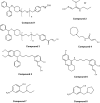Organophosphorus compounds and oximes: a critical review
- PMID: 32506210
- PMCID: PMC7367912
- DOI: 10.1007/s00204-020-02797-0
Organophosphorus compounds and oximes: a critical review
Abstract
Organophosphorus (OP) pesticides and nerve agents still pose a threat to the population. Treatment of OP poisoning is an ongoing challenge and burden for medical services. Standard drug treatment consists of atropine and an oxime as reactivator of OP-inhibited acetylcholinesterase and is virtually unchanged since more than six decades. Established oximes, i.e. pralidoxime, obidoxime, TMB-4, HI-6 and MMB-4, are of insufficient effectiveness in some poisonings and often cover only a limited spectrum of the different nerve agents and pesticides. Moreover, the value of oximes in human OP pesticide poisoning is still disputed. Long-lasting research efforts resulted in the preparation of countless experimental oximes, and more recently non-oxime reactivators, intended to replace or supplement the established and licensed oximes. The progress of this development is slow and none of the novel compounds appears to be suitable for transfer into advanced development or into clinical use. This situation calls for a critical analysis of the value of oximes as mainstay of treatment as well as the potential and limitations of established and novel reactivators. Requirements for a straightforward identification of superior reactivators and their development to licensed drugs need to be addressed as well as options for interim solutions as a chance to improve the therapy of OP poisoning in a foreseeable time frame.
Keywords: Acetylcholinesterase; Nerve agents; Organophosphorus compounds; Oximes; Pesticides; Reactivation.
Conflict of interest statement
The authors declare that there are no conflict of interest.
Figures








Similar articles
-
A comprehensive evaluation of the efficacy of leading oxime therapies in guinea pigs exposed to organophosphorus chemical warfare agents or pesticides.Toxicol Appl Pharmacol. 2014 Dec 15;281(3):254-65. doi: 10.1016/j.taap.2014.10.009. Epub 2014 Oct 31. Toxicol Appl Pharmacol. 2014. PMID: 25448441 Free PMC article.
-
The value of novel oximes for treatment of poisoning by organophosphorus compounds.Pharmacol Ther. 2013 Aug;139(2):249-59. doi: 10.1016/j.pharmthera.2013.04.009. Epub 2013 Apr 17. Pharmacol Ther. 2013. PMID: 23603539 Review.
-
Oximes in organophosphate poisoning: 60 years of hope and despair.Chem Biol Interact. 2016 Nov 25;259(Pt B):93-98. doi: 10.1016/j.cbi.2016.04.032. Epub 2016 Apr 25. Chem Biol Interact. 2016. PMID: 27125761
-
New experimental Oximes in the management of organophosphorus pesticides poisoning.Minerva Anestesiol. 2011 Dec;77(12):1197-203. Epub 2011 Jul 29. Minerva Anestesiol. 2011. PMID: 21799476 Review.
-
Management of Organophosphorus Poisoning.J Nepal Health Res Counc. 2016 Sep;14(34):131-138. J Nepal Health Res Counc. 2016. PMID: 28327676 Review.
Cited by
-
Organophosphate Detoxification and Acetylcholinesterase Reactivation Triggered by Zeolitic Imidazolate Framework Structural Degradation.ACS Appl Mater Interfaces. 2024 Feb 28;16(8):9900-9907. doi: 10.1021/acsami.3c18855. Epub 2024 Feb 12. ACS Appl Mater Interfaces. 2024. PMID: 38344949 Free PMC article.
-
Successful management of a kitten with chlorpyrifos and cypermethrin toxicosis with pralidoxime and atropine.JFMS Open Rep. 2021 Sep 30;7(2):20551169211045647. doi: 10.1177/20551169211045647. eCollection 2021 Jul-Dec. JFMS Open Rep. 2021. PMID: 34616562 Free PMC article.
-
Screening of efficient salicylaldoxime reactivators for DFP and paraoxon-inhibited acetylcholinesterase.RSC Med Chem. 2024 Jan 30;15(4):1225-1235. doi: 10.1039/d3md00628j. eCollection 2024 Apr 24. RSC Med Chem. 2024. PMID: 38665821 Free PMC article.
-
Quantitative Analysis of Muscarinic Antagonist Atropine and Tiotropium in Microvolume Plasma Using Liquid Chromatography-Mass Spectrometry: Application for Pharmacokinetic Studies.J Anal Methods Chem. 2025 Apr 8;2025:9923229. doi: 10.1155/jamc/9923229. eCollection 2025. J Anal Methods Chem. 2025. PMID: 40235671 Free PMC article.
-
A Pralidoxime Nanocomplex Formulation Targeting Transferrin Receptors for Reactivation of Brain Acetylcholinesterase After Exposure of Mice to an Anticholinesterase Organophosphate.Int J Nanomedicine. 2024 Jan 12;19:307-326. doi: 10.2147/IJN.S443498. eCollection 2024. Int J Nanomedicine. 2024. PMID: 38229703 Free PMC article.
References
-
- Ashani Y, Bhattacharjee AK, Leader H, Saxena A, Doctor BP. Inhibition of cholinesterases with cationic phosphonyl oximes highlights distinctive properties of the charged pyridine groups of quaternary oxime reactivators. Biochem Pharmacol. 2003;66:191–202. - PubMed
-
- Aurbek N, Herkert NM, Koller M, Thiermann H, Worek F. Kinetic analysis of interactions of different sarin and tabun analogues with human acetylcholinesterase and oximes: Is there a structure-activity relationship? Chem Biol Interact. 2010;187:215–219. - PubMed
-
- Aurbek N, Thiermann H, Eyer F, Eyer P, Worek F. Suitability of human butyrylcholinesterase as therapeutic marker and pseudo catalytic scavenger in organophosphate poisoning: a kinetic analysis. Toxicology. 2009;259:133–139. - PubMed
-
- Aurbek N, Thiermann H, Szinicz L, Eyer P, Worek F. Analysis of inhibition, reactivation and aging kinetics of highly toxic organophosphorus compounds with human and pig acetylcholinesterase. Toxicology. 2006;224:91–99. - PubMed
Publication types
MeSH terms
Substances
LinkOut - more resources
Full Text Sources
Medical
Miscellaneous

